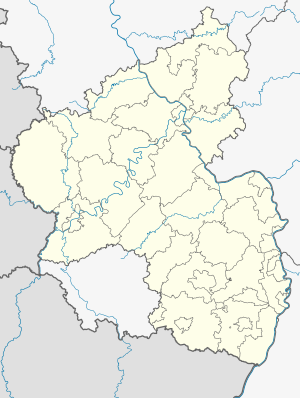Hindenburg Bridge (Moselle)
Coordinates: 49 ° 42 ′ 7 ″ N , 6 ° 33 ′ 31 ″ E
| Hindenburg Bridge | ||
|---|---|---|
| (1943) | ||
| use | railroad | |
| Convicted | Connection of the Trier western route with the Upper Moselle route | |
| Subjugated | Moselle | |
| place | Hedgehog ↔ Wasserliesch | |
| construction | Truss bridge | |
| overall length | 221 m | |
| Longest span | 51 m | |
| opening | April 20, 1912 | |
| Status | Destroyed in 1945 | |
| location | ||
|
|
||
| Preserved bridgehead of the Hindenburg Bridge near Igel / Mosel 2010 | ||
The Hindenburg Bridge , which officially had no name, was a railway bridge over the Moselle between Wasserliesch and Igel ; soon after it was put into operation, the vernacular named it after Field Marshal General and later President Paul von Hindenburg . The bridge, which was commissioned in 1912, was very likely blown up by the Wehrmacht at the end of the Second World War and was not rebuilt afterwards.
history
The truss bridge with a length of 221 m was part of the freight train route Ehrang - Trier Hbf - Karthaus - Igel, which together with the tracks of the Moselle line Koblenz - Perl formed a four-track connection between Trier Hbf and Karthaus. It should relieve the Konzer Moselle Bridge , which has existed since 1861 and is only a little over a kilometer further down the Moselle . Triggered by the increased transport volume with the commissioning of the Eifel route in 1871 and the Moselle route in 1879, considerations arose in 1907 to end the cumbersome pushing of heavy trains from the Konz-Karthaus marshalling yard over the existing Moselle bridge. On April 20, 1912 the so-called Hindenburg Bridge was opened. The heavy coal and coke trains now only used the new railway bridge on the Konz – Igel line.
After the destruction in February 1945, it was decided in 1953 not to rebuild the bridge. The exact circumstances of their destruction are not precisely known. The bridge may have been blown up, but it may also have been bombed. The remains of the river piers were removed in the course of the Moselle canalization in 1960. On the Igeler side, a part of the feeder dam with several bridge arches made of bricks has been preserved.
In June 2016, the regional press reported that Deutsche Bahn , who still owns the ruin and the surrounding property today , would like to auction the remains of the bridge (not listed ) via an auction house .
See also
Web links
- History about the origin of the railway around Igel. In: nims-sauertal-bahn.de
- Datasheet at brueckenweb.de
Individual evidence
- ↑ Under the hammer: Igeler Bridge to buy. In: volksfreund.de





